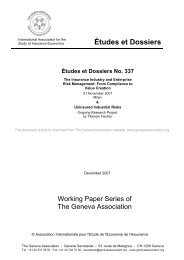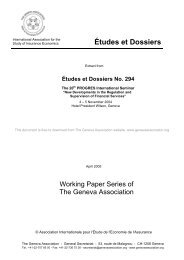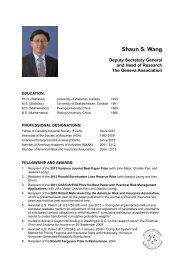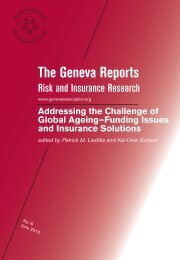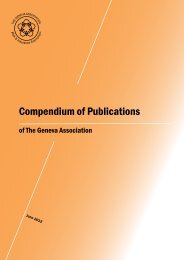Addressing the Challenge of Global Ageing—Funding Issues
Addressing the Challenge of Global Ageing—Funding Issues
Addressing the Challenge of Global Ageing—Funding Issues
You also want an ePaper? Increase the reach of your titles
YUMPU automatically turns print PDFs into web optimized ePapers that Google loves.
34<br />
<strong>Addressing</strong> <strong>the</strong> <strong>Challenge</strong> <strong>of</strong> <strong>Global</strong> Ageing—Funding <strong>Issues</strong> and Insurance Solutions<br />
2. <strong>Global</strong> ageing<br />
The world population has just reached a total <strong>of</strong> seven billion people in 2011. Historically<br />
<strong>the</strong>re has been a long-term growth trend since <strong>the</strong> early days <strong>of</strong> <strong>the</strong> agrarian revolution that<br />
was only sporadically disrupted by wars, famine and epidemics. This trend accelerated<br />
with <strong>the</strong> advent <strong>of</strong> industrial production. Over all <strong>the</strong>se centuries, fertility rates always<br />
remained well above <strong>the</strong> replacement rate (usually understood to be 2.1 children per<br />
woman). It is a ra<strong>the</strong>r recent phenomenon that growth rates would turn negative in certain<br />
countries despite <strong>the</strong> absence <strong>of</strong> wars, famine or epidemics. However, this declining trend<br />
seems to spread around <strong>the</strong> globe and <strong>the</strong> United Nations projects more growth rates to<br />
turn downward or remain negative in <strong>the</strong> coming decades (United Nations, 2010).<br />
Populations throughout <strong>the</strong> world are ageing due to two basic demographic trends,<br />
namely increasing life expectancy and declining fertility rates. Various factors are<br />
usually raised to explain <strong>the</strong>se phenomena. While life expectancy increase is due largely<br />
to lifestyle improvements, rising wealth and medical advances, <strong>the</strong> decrease in fertility<br />
rates is generally explained by birth control, higher female educational attainment and<br />
participation in <strong>the</strong> labour force, and changes in lifestyle and societal values.<br />
While ageing is global, however, <strong>the</strong>re are important international differences in <strong>the</strong><br />
speed and extent <strong>of</strong> <strong>the</strong> ageing process. Among <strong>the</strong> developed countries, Europe and<br />
Japan already have much older populations than North America. Italy and Germany are<br />
ageing faster than France and Great Britain. In Asia, some countries such as China start<br />
from a relatively young population, but due to <strong>the</strong> one-child policy ageing is occurring<br />
rapidly. It is still unclear why countries differ in <strong>the</strong>ir ageing process and some possible<br />
explanations <strong>of</strong> fertility rates such as social security systems or female participation are<br />
not totally understood and open to some interpretation (Cigno, 1995).<br />
Over <strong>the</strong> past century, longevity has accelerated for most countries almost linearly by two<br />
years per decade. Projections on longevity predict a gain <strong>of</strong> around 1.2 years per decade<br />
over <strong>the</strong> next 50 years (United Nations, 2010). Expectations <strong>of</strong> global ageing naturally<br />
depend on longevity and fertility forecasts. However, both fertility and longevity trends<br />
are to a certain degree controversial. For instance, concerning fertility rates, some studies<br />
support <strong>the</strong> idea <strong>of</strong> a fertility cycle, with alternative periods <strong>of</strong> boom and burst <strong>of</strong> fertility<br />
(Van Wissen, 2004). Based on this idea, <strong>the</strong> current decline in fertility would be in part<br />
explained by a shift over time <strong>of</strong> <strong>the</strong> date at which a woman has her first child. A possible<br />
increase in fertility rates could thus be expected in <strong>the</strong>se countries. On <strong>the</strong> contrary,<br />
o<strong>the</strong>r studies tend to show that fertility rates do not follow cycles but are subject ra<strong>the</strong>r<br />
to sudden changes (Bonneuil, 2003). This suggests that future developments are more<br />
uncertain than <strong>of</strong>ten assumed.<br />
In <strong>the</strong> same vein, longevity trends are also debatable and in particular healthy life<br />
expectancy, i.e. life expectancy in good health. Over a long period, increases in life<br />
expectancy at birth have corresponded with improvements in <strong>the</strong> health <strong>of</strong> populations.<br />
However, now that chronic diseases are progressively replacing infectious diseases, <strong>the</strong><br />
prevalence <strong>of</strong> chronic disease in <strong>the</strong> population usually increases as a result <strong>of</strong> longer<br />
survival. Three <strong>the</strong>ories have thus emerged regarding healthy life expectancy. The first<br />
anticipates an improvement in <strong>the</strong> state <strong>of</strong> health and a compression <strong>of</strong> morbidity (Fries,<br />
1980), <strong>the</strong> second a decline in <strong>the</strong> state <strong>of</strong> health and an expansion <strong>of</strong> morbidity (Kramer,<br />
1980), and <strong>the</strong> third, a dynamic equilibrium (Manton 1982) where, though <strong>the</strong> prevalence<br />
<strong>of</strong> morbidity increases as mortality falls, <strong>the</strong> prevalence is on average less. Many unknowns



